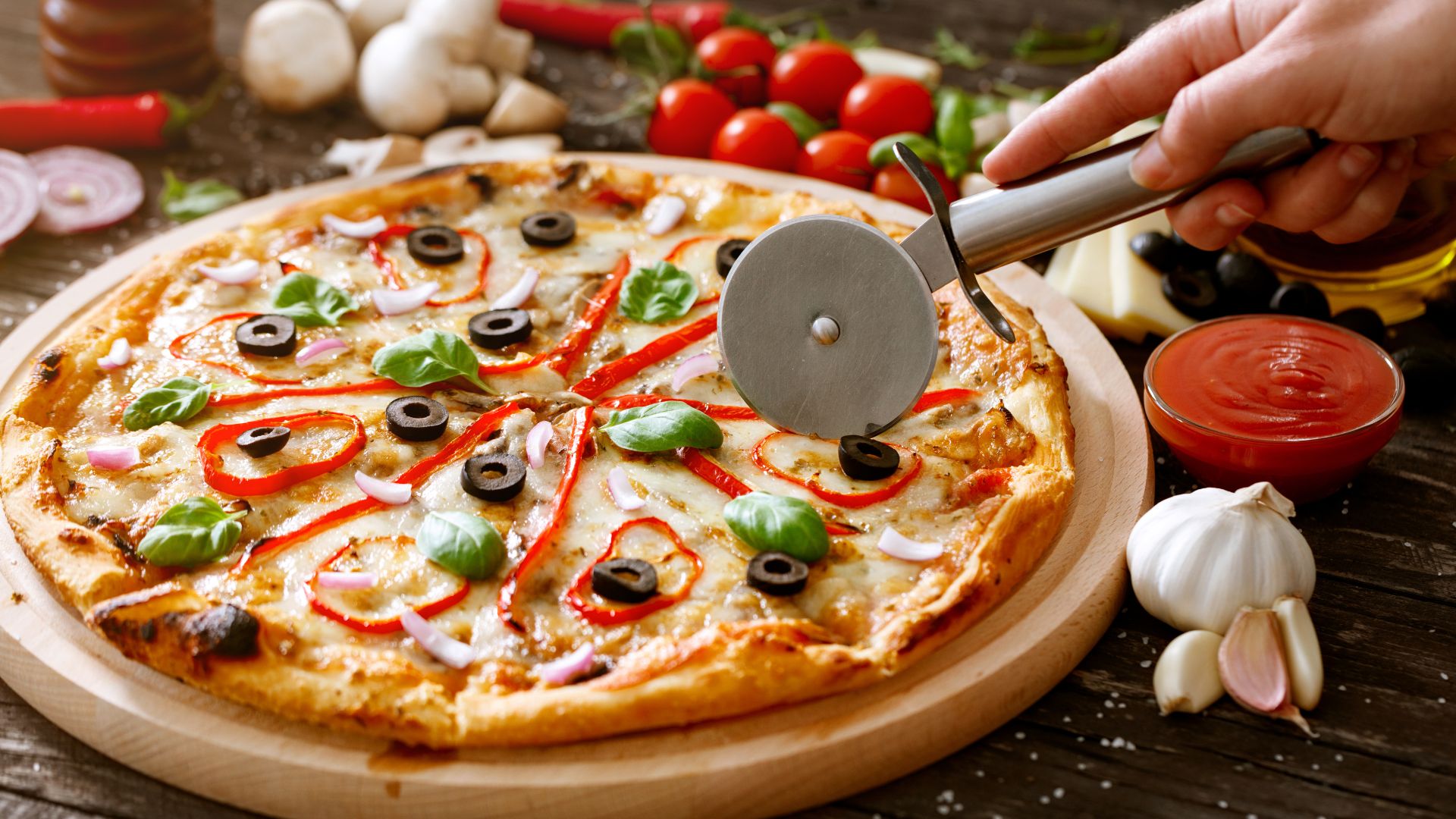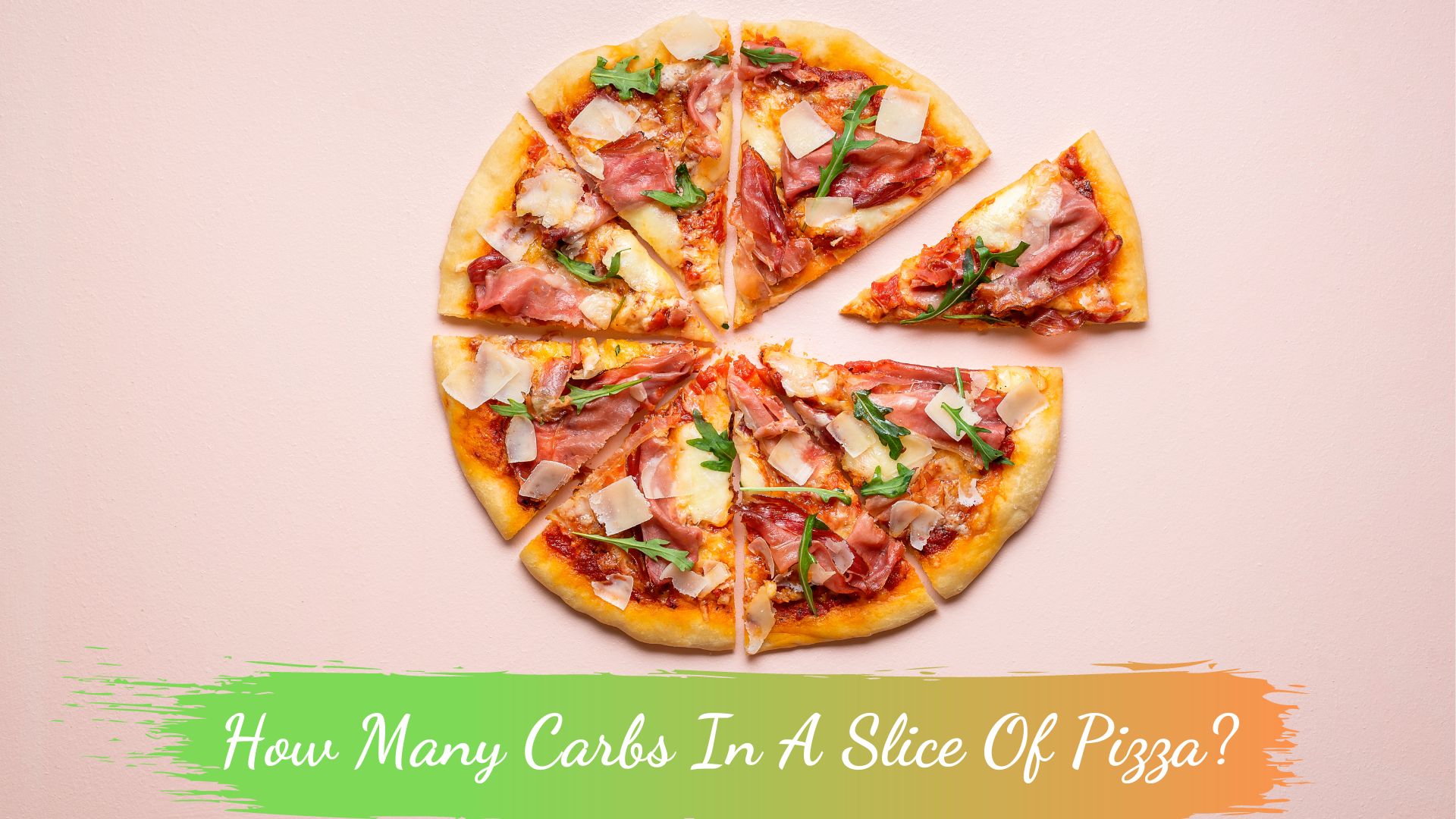How Many Carbs In A Slice Of Pizza?
Do you ever find yourself craving a mouth-watering slice of pizza, but then wondering how many carbs in a slice of pizza? Eating too much unhealthy food can leave us feeling heavy and sluggish, but sometimes we still want to indulge. With so many choices on the menu at restaurants – from thin crust to deep dish pies – finding out the carb content of your favorite slices can be difficult. That’s why today we’ll be exploring exactly how many carbs in a slice of pizza – because everyone should have the freedom to choose their indulgences wisely!

What is a slice of pizza?
A slice of pizza is a single serving of a larger pizza. It is usually cut into triangular or rectangular shapes, and can be topped with various ingredients such as cheese, pepperoni, and vegetables. Whether you purchase it from your local pizzeria or make it at home, this popular food item will surely please everyone in the family.
Pizza slices are a great way to get creative in the kitchen and customize your meal. You can choose from different types of crusts, such as thin crust, deep dish, or even gluten-free options. Add toppings like pepperoni, olives, mushrooms, onions and anything else you like. The possibilities are endless when it comes to creating a great slice of pizza!
What are carbs and their role in our body?
Carbohydrates, or ‘carbs’, are one of the three macronutrients that provide energy for our bodies. The other two macronutrients are protein and fat. Carbs are generally found in grains, fruits, vegetables, legumes and dairy products.
Carbs play an important role in our bodies because they provide energy for everyday activities. They are converted into glucose, which is then used by the cells of our body to produce energy. Glucose is also stored as glycogen in muscles and the liver for future use.
Because carbohydrate-rich foods typically contain more fiber, vitamins and minerals, they can also help provide essential nutrients our bodies need. Eating the right kinds of carbs can also help us maintain a healthy weight by providing energy without excess calories.
Finally, carbohydrates are necessary for proper digestion and the absorption of some vitamins and minerals. They slow down digestion which helps us feel fuller longer, and helps to regulate our blood sugar levels.
What are the different carbs types?
Carbohydrates are divided into three main groups: monosaccharides, disaccharides, and polysaccharides. Monosaccharides are the simplest carbohydrates, including glucose, fructose, and galactose. Disaccharides are composed of two monosaccharide molecules linked together, including sucrose, maltose, and lactose. Polysaccharides are complex carbohydrates and include starches, fiber, and glycogen. Each type of carbohydrate has different properties that affect how it is digested and used for energy in the body. Understanding these differences can help determine which carbs may benefit a given individual or situation more.
Why should you know how many carbs in a slice of pizza?
Eating too many carbs can lead to weight gain and other health issues, so it’s important to know how many carbs are in your favorite foods. Knowing how many carbs in a slice of pizza can help you make healthier choices when ordering or making pizza.
Carbohydrates are one of the three macronutrients that provide energy for our bodies. Generally, a thin-crust pizza will contain fewer carbs than a thick-crust one. The toppings you choose can also affect the carb count in a slice of pizza. For example, adding extra cheese or meats like pepperoni or sausage can increase the carb content. Vegetables like peppers and mushrooms are a low-carb option for topping your pizza.
If you’re watching your carbs, it’s important to know how many carbs in a slice of pizza. Eating too many carbs can lead to weight gain, so being aware of the carb count in common foods is an important part of a healthy diet. Knowing the carb content of pizza can help you make smarter choices when ordering or making one.
How many carbs in a slice of pizza?
How many carbs in a slice of pizza? The exact number of carbs in a single slice of pizza can vary depending on the type of crust and toppings. A regular cheese slice from a large pizza typically contains 25-30 grams of carbohydrates. Adding different types of toppings, such as pepperoni or sausage, to your slice could increase the carb count by 5-10 grams. Pizza crust also affects the carb count—thicker crusts would contain more carbs than thin-crust varieties. Some pizzas may include specialty ingredients that can significantly increase the carbohydrate content, such as honey or garlic butter sauces. Therefore, checking with your pizza provider for exact nutritional information if you’re counting carbs is important.
How many carbs in a slice of pepperoni pizza?
A single slice of pepperoni pizza typically contains around 33-40 grams of carbohydrates. The exact amount will depend on the type of crust and toppings used and the size of the pizza slices. For example, a regular cheese slice with pepperoni topping from a large pizza could contain up to 40 grams of carbohydrates.
How many carbs in a slice of vegetarian pizza?
A single slice of vegetarian pizza typically contains around 22-30 grams of carbohydrates. A slice of pizza with a thin crust, such as whole wheat or multigrain, may contain fewer carbohydrates than a regular cheese slice from a large pizza. Additionally, adding different vegetarian toppings, such as mushrooms or bell peppers, to your slice could increase the carb count by 5-10 grams.
How many carbs in a slice of thin-crust pizza?
A single slice of thin-crust pizza generally contains anywhere from 13 to 30 grams of carbohydrates, depending on the size and toppings.
How many carbs in a slice of deep-dish pizza?
A slice of deep-dish pizza typically contains between 20 and 25 grams of carbs. However, this can vary depending on the type of crust used, toppings added, and slice size. For example, a larger slice (greater than 1/8th of a large pizza) may contain closer to 30 grams of carbohydrates. For a more accurate measurement, check the nutrition facts label on the pizza or ask your server for a breakdown of ingredients.
How many carbs in a slice of Papa John’s pizza?
A slice of Papa John’s Original Cheese Pizza contains 26g of carbohydrates. This includes 2g of dietary fiber and 1g of sugar. The crust is made with enriched wheat flour, high-oleic canola oil, modified food starch, cornstarch, yeast and salt.
How many carbs in a slice of Domino’s pizza?
A single slice of Domino’s pizza can contain anywhere from 25 to 35 grams of carbohydrates, depending on the type and size of the pizza. For example, a regular-size slice of Hand Tossed Cheese Pizza contains 25 grams of carbs while a large Thin Crust Pepperoni Pizza slice has 35 grams.
How many carbs in a slice of Pizza Hut’s pizza?
A slice of Pizza Hut’s pizza contains approximately 26.5 grams of carbohydrates. It also contains about 11 grams of fat and 9.4 grams of protein. Additionally, a single slice has about 243 calories and 810 milligrams of sodium.
How many carbs in a slice of Sbarro’s pizza?
A single slice of Sbarro’s cheese pizza has 24 grams of carbohydrates. However, the amount of carbohydrates in a slice can vary depending on what type of toppings are added. For example, adding pepperoni to a single slice could increase the carbohydrate count by 2 or 3 additional grams per slice.
What is the Calories content of a slice of Pizza?
A typical slice of pizza contains between 200 and 300 calories. However, this can vary greatly depending on the size of the slice and the toppings used. For example, a large slice with extra cheese and pepperoni can have as many as 500 calories or more. Watching portion sizes when eating pizza is important, as it can quickly add up. To make pizza healthier, try topping whole wheat crust with plenty of veggies. This can help reduce the calorie count and provide additional nutrients to your meal.
How can you calculate the carbs content in a slice of pizza?
To calculate the carbs content in a slice of pizza, you need to know how big each slice is and what type of crust it has. Most pizzas have around 35-45 grams of carbohydrates per serving. You can look at the nutritional information on the box or packaging to find out the exact amount for your specific pizza.
Additionally, you can estimate the carbs content in a single slice of pizza by multiplying the total number of servings by the amount of carbohydrates in each serving. For example, if your pizza has 8 servings and 45 grams of carbohydrates per serving, it would have 360 grams of carbohydrates per pizza. Therefore, each slice would contain an estimated 45 grams of carbohydrates.
Variables that affect pizza’s carb content
Some factors can affect the carb content in a pizza slice:
Crust type
The number of carbohydrates in pizza can vary significantly, depending on the type of crust used, and the toppings added. The type of flour used to make the crust will also have an impact on its carb content. For instance, whole wheat or multigrain doughs tend to be higher in carbs than white flour-based doughs. Additionally, deep dishes or thick crusts will usually have more carbs than thin and regular crusts.
Toppings and sauces
Pizza toppings can also play a role in determining the carb content of a single slice. Toppings like pepperoni, bacon, and sausage contain no carbohydrates; however, vegetables like mushrooms, onions, peppers, and olives are higher in carbohydrates. In addition, sauces like marinara or alfredo typically contain added sugars and starches that can increase the carb content of a pizza slice.
Slice size
The size of the slice can also affect the amount of carbohydrates in a pizza. As with most foods, a larger portion contains more carbs than a smaller one. For example, two slices from an extra-large pizza will contain more carbs than two slices from a small or medium-sized pizza.
Different carbs types in a slice of pizza
The type of carbs found in a slice of pizza will depend on the ingredients used to make it. Generally speaking, most pizzas are made with dough that contains wheat flour, which is composed primarily of complex carbohydrates. The majority of these carbohydrates come from starches and fibers, though some simple sugars may be included as well. Other ingredients like cheese and tomato sauce may contribute to the overall carbohydrate content.
What advantages do carbohydrates provide for your health?
Carbohydrates offer several health benefits. First, they are an important energy source for the body to fuel us through physical activity, mental tasks and everyday life. They also help store and supply energy to muscles, enabling them to perform optimally during intense activities like exercise.
Carbohydrates also play an important role in brain function. Studies have shown that a carbohydrate diet can improve memory, concentration and other cognitive abilities. They can even help boost mood by increasing the production of serotonin – a hormone associated with happiness and well-being.
Finally, many complex carbohydrates contain essential nutrients like vitamins, minerals and fiber. These nutrients help to support a healthy immune system and reduce the risk of certain diseases like diabetes, heart disease and cancer.
Nutrition Facts for a slice of pizza
Serving size: 1 slice (68 g)
Calories: 272
Total Fat: 12 g
Saturated fat: 5g
Trans fat: 0g
Cholesterol: 17mg
Sodium: 351mg
Total Carbohydrate: 30g
Dietary Fiber: 2g
Sugars: 3g
Protein: 11g
Vitamin A: 0%
Vitamin C: 1%
Calcium: 14%
Iron: 10%
Common mistakes to avoid about how many carbs in a slice of pizza
- Not accounting for the crust: Depending on the type of crust and its thickness, you may add a substantial amount of carbs to your pizza slice. Check the nutrition facts label to find exactly how many carbs are coming from the crust.
- Ignoring ingredients: Consider all the ingredients used on your pizza slice. Extra cheese, vegetables, meats and sauces can all add to the carb count.
- Not accounting for toppings: Toppings like pepperoni or sausage can add significant carbs to your pizza slice. Be sure to check the nutrition facts label to find exactly how many carbs are in each topping before indulging.
- Assuming all pizza slices are the same size, not all are created equal. Depending on where you order from, a slice of pizza can range from just a few inches to nearly half a foot in diameter. It’s important to take this into account when calculating your carb intake.
- Forgetting about portion size: Even if you know the exact number of carbs in a slice, remember it’s just one piece. Eating multiple slices can drastically increase your carb intake for the meal. Be sure to count each additional slice when calculating how many carbs are in your pizza.
Further, it’s important to remember that pizza is meant to be enjoyed in moderation. While it can make a tasty treat, it’s also high in calories and carbs. Practice portion control and monitor your carb intake when indulging in pizza.
FAQs about how many carbs in a slice of pizza
Are there any options for low-carb pizza crusts?
Yes, there are various low-carb pizza crust options available. These include cauliflower crusts, almond flour crusts, and gluten-free doughs. Each option contains fewer carbs than a traditional wheat or white flour crust. Additionally, you can always opt for an open-faced sandwich instead of a regular slice of pizza if you are looking for a low-carb option.
Does a pizza’s carb content vary depending on the type of cheese used?
Yes, the type of cheese used on a pizza can impact its carb content. For example, mozzarella contains about 0.4 g of carbohydrates per ounce, while cheddar cheese contains about 1.2 g of carbohydrates per ounce. Additionally, cream cheeses and goat cheeses tend to have higher carb counts than other types of cheese.
How do various pizza sauce varieties impact the amount of carbohydrates?
The amount of carbohydrates in pizza sauce can vary depending on the type used. For example, traditional tomato-based sauces generally have a lower carb count than cream-based or pesto. Some pizza sauces may contain added sweeteners and preservatives, which can add to the total carbohydrate content. It is best to read labels carefully when selecting a pizza sauce to ensure you know the exact amount of carbs it contains.
How many carbs are there in a slice of gluten-free pizza?
The amount of carbs in a slice of gluten-free pizza will vary depending on the type of crust and toppings used. Generally, though, a single slice of gluten-free pizza will contain between 10 and 15 grams of carbohydrates. When compared to a traditional wheat or white flour crust, this is significantly lower.
Can a pizza slice’s carbohydrate count change depending on the eatery or brand?
Yes, the carbohydrate count of a pizza slice can vary depending on the eatery or brand. Different restaurants may use different ingredients and toppings that can affect the amount of carbohydrates in each slice. Additionally, some brands offer “low-carb” pizzas specifically designed to be lower in carbs than traditional recipes.
How many carbohydrates are there in a slice of extra cheese pizza?
A single slice of extra cheese pizza can contain between 15 and 25 grams of carbohydrates. This is due to the additional cheese, which adds more carbohydrates than a regular pizza slice.
How is the carbohydrate content of pizza affected by the cooking method?
The cooking method used to prepare a pizza can impact its carbohydrate content. For example, pizzas cooked using a wood-fired oven tend to be lower in carbs than pizzas cooked with electric or gas ovens. Additionally, pizzas that are grilled or pan-fried will contain fewer carbohydrates than those that are deep-fried.
How many carbohydrates are there in a slice of plain pizza?
A single slice of plain pizza typically contains between 10 and 15 grams of carbohydrates.
Are there many carbohydrates in pizza?
Generally, though, a single slice of regular cheese pizza can contain between 10 and 25 grams of carbohydrates. Low-carb options are also available for those who wish to minimize their carb intake.
How many carbohydrates are there in a cheese pizza slice?
A single slice of cheese pizza typically contains between 10 and 15 grams of carbohydrates.
Conclusion on how many carbs in a slice of pizza
Now you should know how many carbs in a slice of pizza. The amount of carbs in a pizza slice depends on the pizza’s type and size. A typical one-slice serving of a regular cheese or pepperoni pizza may contain around 20 to 35 grams of carbohydrates. Going for a thin crust option or making modifications such as removing some toppings can help reduce this number, while opting for a thick crust or adding extra toppings may increase the carb content. Ultimately, it’s important to consider your individual dietary goals when deciding how many carbs in a slice of pizza is right for you.
References:
What Is in Your Slice of Pizza?
Fast Food, Pizza Chain, 14″ pizza, cheese topping, regular crust

